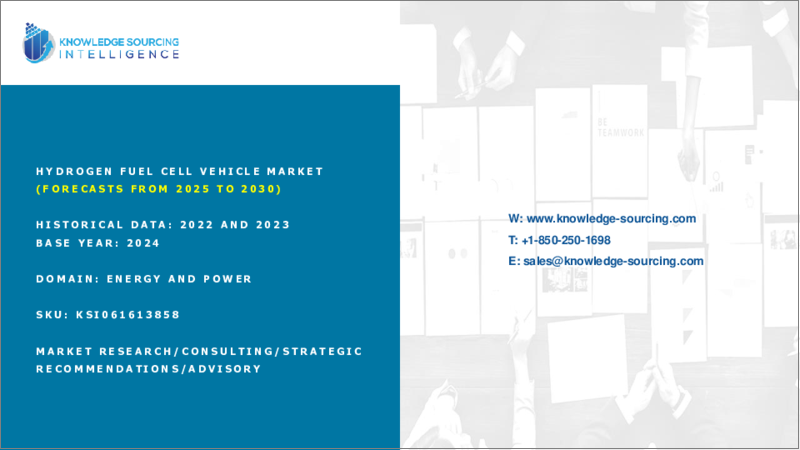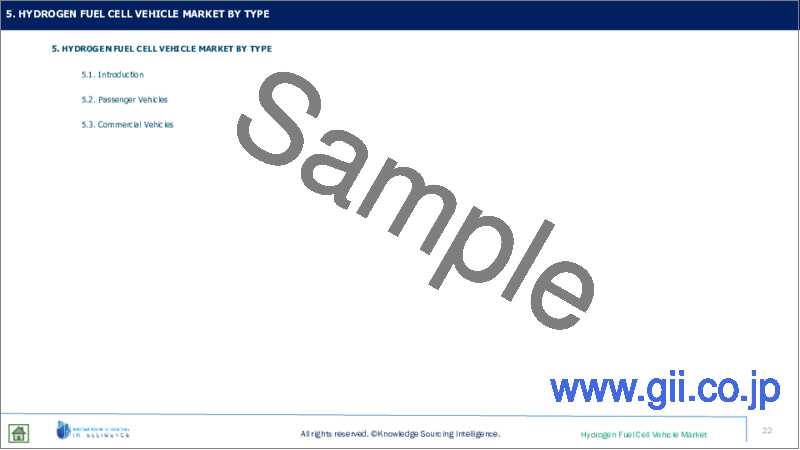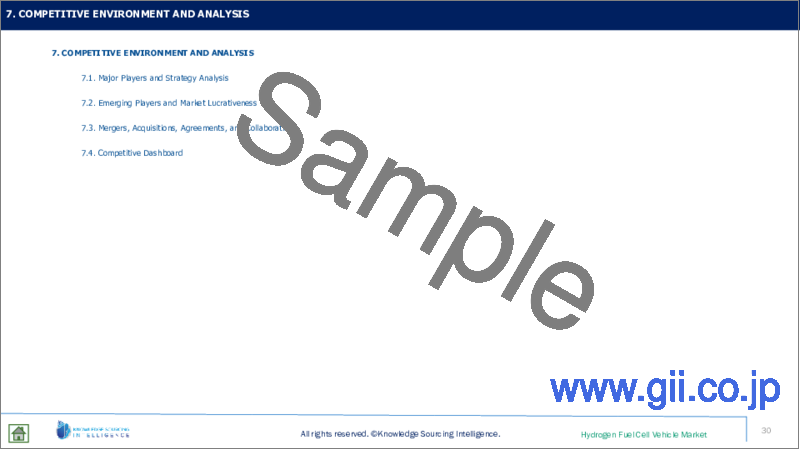|
|
市場調査レポート
商品コード
1627730
水素燃料電池自動車の世界市場:予測(2025年~2030年)Hydrogen Fuel Cell Vehicle Market - Forecasts from 2025 to 2030 |
||||||
カスタマイズ可能
|
|||||||
| 水素燃料電池自動車の世界市場:予測(2025年~2030年) |
|
出版日: 2024年12月23日
発行: Knowledge Sourcing Intelligence
ページ情報: 英文 145 Pages
納期: 即日から翌営業日
|
全表示
- 概要
- 目次
世界の水素燃料電池自動車の市場規模は、2025年の83億1,424万3,000米ドルから予測期間中にCAGR19.78%で成長し、2030年には204億9,541万3,000米ドルに達すると予測されています。
従来の燃料を動力源とする自動車から排出される有害な影響に関する世界の懸念の高まりが、科学界を環境に優しい代替動力源へと押し上げています。再生可能エネルギー分野はこの方向で大きく前進していますが、従来の燃料と同レベルのパワーと信頼性を提供できる完璧なエネルギー源を見つけることは、まだ達成されていない目標です。自動車の動力源となる代替燃料への莫大な投資は、水素燃料電池の分野でも進歩をもたらしています。電線に電荷が流れると電流が流れるという原理で作動する従来の電力供給と同様に、水素もまた膨大なエネルギーを生み出し、供給することができます。水素燃料電池は、自動車に搭載された水素を確実かつ安全に貯蔵することが求められるため、自動車業界に次のディスラプションの波をもたらすと期待されています。
水素燃料電池は、化学ガスと酸化剤が関与する反応によって電流または電力を生成する電気化学装置と定義することができます。陽極と電解質の助けを借りて、燃料電池は反応物中のプラスイオンとマイナスイオンを分解して電気を発生させます。この技術は非常に持続可能であるため、将来的に非常に有望です。燃料電池で使用される反応剤は、反応剤間の化学反応による副産物である水であるため、環境に対するリスクはありません。この技術は効率が高いため、直流(DC)発電に適しており、自動車やその他の乗り物に電力を供給することができます。研究者たちは、水素燃料電池自動車に持続可能性を持たせるため、水素燃料電池と高度な制御システムの統合を目指しています。
価格が下がり続けていることも、燃料電池自動車(FCV)の人気に拍車をかけています。FCVの価格はここ数年で劇的に下落しており、この下落は今後10年、さらにはそれ以降も続くと思われます。
水素燃料電池自動車は、インフラ面から見ても収益性が高いです。燃料電池車は現在でもやや高価ですが、その高価格は、燃料補給インフラにかかるコストがかなり低いため、ある程度相殺されます。簡単に言えば、燃料電池バスの台数が増えれば増えるほど、燃料電池バスに起因するインフラのコストは減少します。一方、充電ステーションあたりのバッテリー電気バスの台数が増えれば、より多くの電力が必要となるため、1台あたりのインフラコストは上昇します。
つまり、水素燃料は今後も安くなると予想されます。再生可能エネルギーを低コストで生産することで、一部の地域では従来の燃料価格と同程度のグリーン水素の生成がサポートされるため、水素燃料電池自動車はよりスマートでコスト効率の高い移動手段であり、おそらく未来のスマートモビリティとなると思われます。このような自動車の採用は、予測期間中も増加し続けると予想され、市場成長を後押しします。
この燃料技術を使用した自動車の生産台数の増加は、予測期間中の市場成長にプラスの影響を与えると予想されます。例えば、ホンダは2024年6月に新型2025ホンダCR-V e:FCEV燃料電池電気自動車(FCEV)の生産をオハイオ州のパフォーマンス・マニュファクチャリング・センター(PMC)で開始しました。新型CR-V e:FCEVは、米国で生産される唯一のFCEVであり、米国製の新型燃料電池システムとプラグインEV充電機能を組み合わせた米国初の水素FCEVです。
水素電池自動車市場の地理的展望:
- 予測期間中、北米と欧州が大きな市場シェアを占めると予想される
市場セグメンテーションは、北米、南米、欧州・中東・アフリカ、アジア太平洋に区分されています。より明確に把握するため、これらの地域市場はさらに市場シェアの大きい国々に区分されています。
北米と欧州は新技術をいち早く採用することで知られ、市場全体の大きなシェアを占めています。これらの地域の市場成長の主な要因は、最先端のインフラが存在することにあります。支援インフラが利用できるため、顧客は水素燃料電池自動車への傾斜を強めています。さらに、これらの地域では環境保護に関する規制が厳しく、法執行機関により厳格に実施されているため、人々はより持続可能で環境に優しいソリューションを採用するようになっています。水素燃料電池自動車は市場に投入されたばかりであるため価格は高いですが、これらの地域では可処分所得の高い人口が多いです。こうした動向が、これらの地域の顧客による水素燃料電池自動車の採用を促進し、市場成長を後押ししています。
アジア太平洋は、この市場にとって計り知れない成長の可能性を秘めているため、水素燃料電池自動車メーカーにとって最も有利な市場の一つです。中国、日本、韓国は、これらの自動車の採用をサポートするインフラを備えているため、市場企業にとって非常に有利な市場です。日本は世界で最も先進的な経済のひとつであり、さまざまな面で環境保護に大きく貢献してきました。市場関係者は、この地域が持つ成長ポテンシャルを利用しようとしており、各国への投資を活発化させています。このことは、予測される期間にわたって市場成長を牽引し続けると予想されます。
本レポートを購入する理由
- 洞察に満ちた分析:顧客セグメント、政府政策と社会経済要因、消費者嗜好、業界、その他のサブセグメントに焦点を当て、主要地域だけでなく新興地域もカバーする詳細な市場考察を得ることができます。
- 競合情勢:世界の主要企業が採用する戦略的作戦を理解し、適切な戦略による市場浸透の可能性を理解することができます。
- 市場動向と促進要因:ダイナミックな要因と極めて重要な市場動向、そしてそれらが今後の市場展開をどのように形成していくかを探ります。
- 実行可能な提言:ダイナミックな環境の中で新たなビジネスストリームと収益を発掘するための戦略的決断を下すために、洞察を活用します。
- 幅広い利用者に対応:新興企業、研究機関、コンサルタント、中小企業、大企業にとって有益で費用対効果が高くなっています。
どのような用途で利用されていますか?
業界および市場考察、事業機会評価、製品需要予測、市場参入戦略、地理的拡大、設備投資の決定、規制の枠組みと影響、新製品開発、競合の影響
調査範囲
- 2022年~2030年の実績データと予測
- 成長機会、課題、サプライチェーンの展望、規制枠組み、顧客行動、動向分析
- 競合のポジショニング、戦略、市場シェア分析
- セグメントと各国を含む地域の収益成長と予測分析
- 企業プロファイル(主に戦略、製品、財務情報、主要な発展など)
目次
第1章 イントロダクション
- 市場概要
- 市場の定義
- 調査範囲
- 市場セグメンテーション
- 通貨
- 前提条件
- 基準年と予測年のタイムライン
- 利害関係者にとっての主なメリット
第2章 調査手法
- 調査デザイン
- 調査プロセス
- データ検証
第3章 エグゼクティブサマリー
- 主な調査結果
- アナリストの見解
第4章 市場力学
- 市場促進要因
- 市場抑制要因
- ポーターのファイブフォース分析
- 業界バリューチェーン分析
第5章 水素燃料電池自動車市場:タイプ別
- イントロダクション
- 乗用車
- 商用車
第6章 水素燃料電池自動車市場:地域別
- イントロダクション
- 南北アメリカ
- 欧州・中東・アフリカ
- アジア太平洋
第7章 競合環境と分析
- 主要企業と戦略分析
- 新興企業と市場収益性
- 合併・買収・協定・協業
- 競合ダッシュボード
第8章 企業プロファイル
- Toyota Motor Corporation
- Hyundai Motor Company
- BayerischeMotoren Werke AG
- Mercedes-Benz Group AG
- Honda Motor Company
- Nikola Corporation
The hydrogen fuel cell vehicle market is valued at US$8,314.243 million in 2025 and is expected to grow at a CAGR of 19.78% over the forecast period to reach US$20,495.413 million in 2030.
Increasing concerns worldwide regarding the harmful effects of emissions from vehicles powered by conventional fuels have pushed the scientific community towards eco-friendly alternatives to power vehicles. Although the renewable energy sector has come a long way in this direction, finding a perfect energy source that can offer the same level of power and reliability as conventional fuels is still a target unmet. Huge investments that are flowing into alternative fuels for powering vehicles have been bringing about advancements in the field of hydrogen fuel cells as well. Like conventional electricity supply, which works on the principle that charge flowing through a wire leads to the flow of electric current, hydrogen can also produce and deliver huge amounts of energy. Since onboard hydrogen storage in vehicles reliably and safely is required, hydrogen fuel cells are expected to bring about the next wave of disruption in the automotive industry.
A hydrogen fuel cell can be defined as an electrochemical device that generates electric current or power with the help of reactions that involve chemical gases and oxidants. With the help of anodes and electrolytes, fuel cells split the positive and negative ions in the reactant to generate electricity. This technology is very promising for the future because it is very sustainable. Reactants used in fuel cells do not pose any risk to the environment as water is the by-product of the chemical reaction between them. The high efficiency of this technology makes it fit for use in the generation of direct current (DC), which can power cars and other vehicles. Researchers are working towards integrating hydrogen fuel cells with advanced control systems to add sustainability to hydrogen fuel cell vehicles.
Their continuously declining prices are also spurring the popularity of fuel-cell vehicles (FCVs). The FCVs have been witnessing a dramatic decline in prices over the past few years, and this decline will continue to hold ground over the next decade and even beyond that.
Hydrogen fuel cell vehicles are profitable even from an infrastructure point of view. Although fuel cell vehicles are still somewhat expensive today, their high price is offset to some extent by the fairly low cost that goes into refueling infrastructure. Simply put, the cost of infrastructure attributed to fuel cell buses decreases as the volume of fuel cell buses increases. On the other hand, an increase in the number of battery-electric buses per charging station raises the infrastructure cost per vehicle since there is a need for more power.
In short, hydrogen fuel is expected to continue to get cheaper. As producing renewable energy at low cost supports the generation of green hydrogen at parity with conventional fuel prices in some regions, hydrogen fuel cell vehicles are smarter and more cost-efficient modes of mobility and perhaps the future of smart mobility. The adoption of these vehicles is expected to continue increasing over the projected period, thus propelling the market growth.
The increasing production of vehicles using this fuel technology is anticipated to positively influence market growth in the projected period. For instance, in June 2024, Honda began the production of the all-new 2025 Honda CR-V e: FCEV fuel cell electric vehicle (FCEV) at the Performance Manufacturing Center (PMC) in Ohio. The all-new CR-V e: FCEV is the only FCEV built in America and the first U.S.-produced hydrogen FCEV to combine an all-new U.S.-made fuel cell system with plug-in EV charging capability.
Hydrogen Cell Vehicle Market Geographic Outlook:
- The North American and European regions are expected to hold a major market share in the projected period.
Geographically, the hydrogen fuel cell vehicle market has been segmented into North America, South America, Europe, the Middle East and Africa, and the Asia Pacific. To give a clearer view, these regional markets have been further segmented into countries with a significant market share.
North America and Europe are known to be the early adopters of new technologies, accounting for a significant share of the overall market. Market growth in these regions is majorly attributed to the presence of state-of-the-art infrastructure. Since supportive infrastructure is available, customers are increasing their inclination toward hydrogen fuel cell vehicles. Furthermore, stringent regulations in these regions regarding environmental protection and their strict implementation by law enforcement agencies have been pushing people to adopt more sustainable and environment-friendly solutions. Although these vehicles' prices are high because they are new in the market, these regions have a large chunk of the population with high disposable income. These trends are driving the adoption of hydrogen fuel cell vehicles among customers in these regions, thus propelling the market growth.
Asia-Pacific is one of the most lucrative markets for hydrogen fuel cell vehicle manufacturers, as this region holds immense growth potential for this market. China, Japan, and South Korea are very lucrative markets for market players as they have the infrastructure to support the adoption of these vehicles. Japan is one of the most advanced economies in the world and has been contributing significantly to the protection of the environment on various fronts. As market players seek to tap into the growth potential held by this region, they are pumping investments into countries. This is expected to continue driving the market growth over the projected period.
Reasons for buying this report:-
- Insightful Analysis: Gain detailed market insights covering major as well as emerging geographical regions, focusing on customer segments, government policies and socio-economic factors, consumer preferences, industry verticals, other sub- segments.
- Competitive Landscape: Understand the strategic maneuvers employed by key players globally to understand possible market penetration with the correct strategy.
- Market Drivers & Future Trends: Explore the dynamic factors and pivotal market trends and how they will shape up future market developments.
- Actionable Recommendations: Utilize the insights to exercise strategic decision to uncover new business streams and revenues in a dynamic environment.
- Caters to a Wide Audience: Beneficial and cost-effective for startups, research institutions, consultants, SMEs, and large enterprises.
What do businesses use our reports for?
Industry and Market Insights, Opportunity Assessment, Product Demand Forecasting, Market Entry Strategy, Geographical Expansion, Capital Investment Decisions, Regulatory Framework & Implications, New Product Development, Competitive Intelligence
Report Coverage:
- Historical data & forecasts from 2022 to 2030
- Growth Opportunities, Challenges, Supply Chain Outlook, Regulatory Framework, Customer Behaviour, and Trend Analysis
- Competitive Positioning, Strategies, and Market Share Analysis
- Revenue Growth and Forecast Assessment of segments and regions including countries
- Company Profiling (Strategies, Products, Financial Information, and Key Developments among others)
The Hydrogen Fuel Cell Vehicle market is segmented and analyzed as follows:
By Type
- Passenger Vehicles
- Commercial Vehicles
By Geography
- Americas
- Europe, the Middle East, and Africa
- Asia Pacific
TABLE OF CONTENTS
1. INTRODUCTION
- 1.1. Market Overview
- 1.2. Market Definition
- 1.3. Scope of the Study
- 1.4. Market Segmentation
- 1.5. Currency
- 1.6. Assumptions
- 1.7. Base and Forecast Years Timeline
- 1.8. Key Benefits for the Stakeholders
2. RESEARCH METHODOLOGY
- 2.1. Research Design
- 2.2. Research Process
- 2.3. Data Validation
3. EXECUTIVE SUMMARY
- 3.1. Key Findings
- 3.2. Analyst View
4. MARKET DYNAMICS
- 4.1. Market Drivers
- 4.2. Market Restraints
- 4.3. Porter's Five Forces Analysis
- 4.3.1. Bargaining Power of Supplier
- 4.3.2. Bargaining Power of Buyers
- 4.3.3. Threat of New Entrants
- 4.3.4. Threat of Substitutes
- 4.3.5. Competitive Rivalry in the Industry
- 4.4. Industry Value Chain Analysis
5. HYDROGEN FUEL CELL VEHICLE MARKET BY TYPE
- 5.1. Introduction
- 5.2. Passenger Vehicles
- 5.3. Commercial Vehicles
6. HYDROGEN FUEL CELL VEHICLE MARKET BY GEOGRAPHY
- 6.1. Introduction
- 6.2. Americas
- 6.3. Europe, the Middle East, and Africa
- 6.4. Asia Pacific
7. COMPETITIVE ENVIRONMENT AND ANALYSIS
- 7.1. Major Players and Strategy Analysis
7.2.Emerging Players and Market Lucrativeness
7.3.Mergers, Acquisitions, Agreements, and Collaborations
7.4.Competitive Dashboard
8. COMPANY PROFILES
- 8.1. Toyota Motor Corporation
- 8.2. Hyundai Motor Company
- 8.3. BayerischeMotoren Werke AG
- 8.4. Mercedes-Benz Group AG
- 8.5. Honda Motor Company
- 8.6. Nikola Corporation






